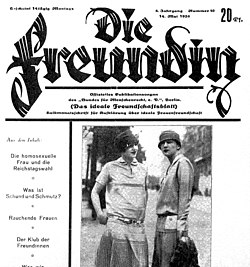
Back Die Freundin Catalan Die Freundin (Zeitschrift) German Die Freundin Spanish Die Freundin French Die Freundin Italian
 An issue of Die Freundin (May 1928) | |
| Categories | Lesbian magazine |
|---|---|
| Publisher | Friedrich Radszuweit |
| First issue | 8 August 1924 |
| Final issue | 8 March 1933 |
| Country | Germany |
| Based in | Berlin |
| Language | German |
Die Freundin (English: "The Girlfriend")[1][2] was a popular Weimar-era German lesbian magazine[3] published from 1924 to 1933.[4][5] Founded in 1924, it was the world's first lesbian magazine, closely followed by Frauenliebe and Die BIF (both 1926). The magazine was published from Berlin, the capital of Germany, by the Bund für Menschenrecht (translated variously as League for Human Rights or Federation for Human Rights and abbreviated as BfM), run by gay activist and publisher Friedrich Radszuweit.[4][6] The Bund was an organization for homosexuals which had a membership of 48,000 in the 1920s.[4]
Die Freundin and other lesbian magazines of that era such as Frauenliebe (Love of Women) represented a part-educational and part-political perspective, and they were assimilated with the local culture.[7] Die Freundin published short stories and novellas.[3] Renowned contributors were pioneers of the lesbian movement like Selli Engler or Lotte Hahm. The magazine also published advertisements of lesbian nightspots, and women could place their personal advertisements for meeting other lesbians.[4] Women's groups related to the Bund für Menschenrecht and Die Freundin offered a culture of readings, performances, and discussions, which was an alternative to the culture of bars. This magazine was usually critical of women for what they viewed as "attending only to pleasure", with a 1929 article urging women: "Don't go to your entertainments while thousands of our sisters mourn their lives in gloomy despair."[6]
Die Freundin, along with other gay and lesbian periodicals, was shut down by the Nazis after they came to power in 1933. But even before the rise of the Nazis, the magazine faced legal troubles during the Weimar Republic. From 1928 to 1929, the magazine was shut down by the government under a law that was supposed to protect youth from "trashy and obscene" literature. During these years, the magazine operated under the title Ledige Frauen (Single Women).[6]
- ^ Corey K. Creekmur; Alexander Doty (1995). Out in culture: gay, lesbian, and queer essays on popular culture. Continuum International Publishing Group. p. 160. ISBN 978-0-304-33488-9. Retrieved 16 February 2012.
- ^ Robert Aldrich; Garry Wotherspoon (21 February 2003). Who's who in gay and lesbian history: from antiquity to World War II. Psychology Press. p. 445. ISBN 978-0-415-15983-8. Retrieved 16 February 2012.
- ^ a b Friederike Ursula Eigler (1997). The feminist encyclopedia of German literature. Greenwood Publishing Group. p. 281. ISBN 978-0-313-29313-9. Retrieved 16 February 2012.
- ^ a b c d Magee, Diana C.; Miller, Maggie (December 1997). Lesbian lives: psyschoanalytic narratives old and new. Analytic Press. pp. 350–351. ISBN 978-0-88163-269-9. Retrieved 16 February 2012.
- ^ Cite error: The named reference
:7was invoked but never defined (see the help page). - ^ a b c Leila J. Rupp (1 December 2009). Sapphistries: a global history of love between women. NYU Press. pp. 193–196. ISBN 978-0-8147-7592-9. Retrieved 16 February 2012.
- ^ B. Ruby Rich (January 1998). Chick flicks: theories and memories of the feminist film movement. Duke University Press. p. 203. ISBN 978-0-8223-2121-7. Retrieved 16 February 2012.